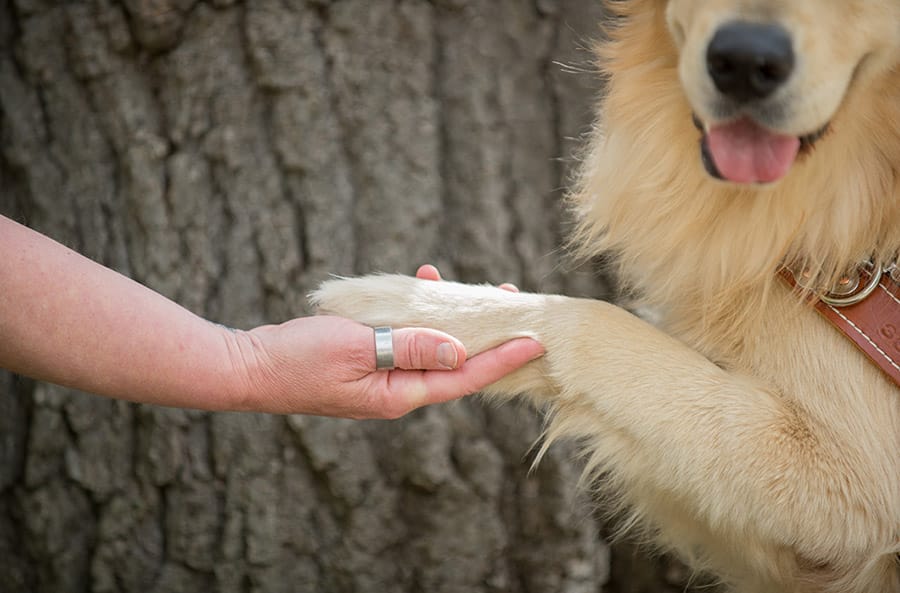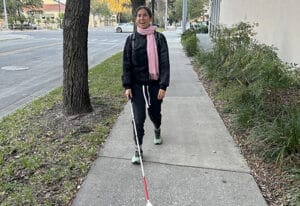
People are spending much more time at home right now, and many have been looking for new activities and companionship. This has contributed to a surge in adoptions of shelter animals and the number of people fostering pets. If you or someone you know is working with a new puppy or dog, this article from Leader Dog’s Coordinator of Prison Puppies Melissa Raymond, LVT, KPA-CTP, may be helpful.
Terminology and phrases such as “cooperative care,” “Fear Free®” and “Low Stress Handling®” are becoming more and more popular in the world of pet lovers. Their meanings are similar despite the difference in wording. When training your dog with cooperative care methods, the goal is to allow your dog to be a willing participant in the process and “say no” if they experience anxiety or stress. You’re training your dog not just to listen to you; you’re also training yourself to listen to your dog.
Let’s explore a scenario where plans might change to work with a dog cooperatively. A team of veterinary professionals are seeing a canine patient with very long nails, the kind that are nearly curling into the dog’s paw pads. The owners do not trim the nails at home because the dog is difficult to control and runs away once the nail trimmers come out of the closet. Though they live close to a groomer and the veterinary office, the dog is afraid of going to both. He whines, wiggles and tries to escape the entire time he is there getting his nails trimmed. His last nail trim was a year ago and for the first time he bared his teeth during the procedure. It took three of the veterinary team members to hold the dog in place while a fourth trimmed his nails.
Now, he is back again, and his nails are worse than ever! This veterinary team knows how important it is to have trimmed nails for any dog. Having long nails can impact the way the dog walks and could cause orthopedic changes in their body. At the simplest level, long nails can cause discomfort. So, the veterinary team has couple of paths that they can take in this scenario. If they were focused solely on the dog’s physical well-being and insist that the nails should be clipped immediately to alleviate physical discomfort, they may attempt to repeat last year’s procedure where it took the three people to hold the dog in place while the nails were trimmed. If the veterinary team’s focus was more on the emotional well-being of this dog and avoiding stress, their goal would be to trim the nails in a way or at a pace in which the dog stayed under the threshold of being afraid.
To stay under the threshold of fear, the veterinary team may need to prescribe medication to decrease fear. They may need to break the aspects of the nail trim down in small pieces to make it a more comfortable experience for the dog, such as having a single nail trimmed each day. The vet team may teach the owner how to prepare the dog for nail trims at home and/or introduce high value treats into the procedure to make it more enjoyable, etc.
The list doesn’t end there. There are lots of cooperative, Low Stress® and Fear Free® methods that can be implemented to make this experience much more comfortable for the dog.
Here are some helpful tips to keep in mind as you train cooperative behaviors with your own dog: everything must be voluntary and completely willing on the dog’s (or any learner’s) behalf. Cooperative behaviors should not include forceful actions. For example: if you are attempting to teach the dog to be comfortable with his foot being grabbed or held in preparation for a nail trim or paw wiping, and the dog wiggles, pulls or jerks his paw back, even just a little, then it is important to make note of this. This is not cooperative. Though it is subtle, the dog is demonstrating to you that there is a level of fear or discomfort present. In order to be successful, you are going to need to do less. Doing less may mean acting like you are going to grab the paw without doing so or holding the paw for a minuscule amount of time before wiggling or jerking begins.
Be sure to mark the successful moment! When your hand comes near the paw or you can hold the paw without the dog wiggling—even for just a second—that’s a success. Communicate to your dog that you like that behavior and you want to see more of it by saying “YES” in an upbeat tone the moment the dog performs the behavior you wanted. Then, immediately follow the “YES” with a treat. In the scenario above, holding onto the paw until the animal stops resisting is not teaching cooperation. That technique could make paw wiping or nail trimming more difficult in the future. Remember that cooperation is all about your dog telling you what they are comfortable with and you listening.
If teaching cooperative behaviors is new to you and your dog, remind yourself to practice short sessions. Learning is tiring for both ends of the leash. Consider setting a timer for 2–5 minutes or whatever short amount of time feels comfortable for you. You can also set aside a certain number of treats for that session. Once your treats are gone, the session is over. Another helpful tip is to practice outside of the context of the necessary situation. For example, if your dog is diagnosed with an ear infection, it would not be the best time to begin cooperative care training for medication application. In that scenario, your dog is already experiencing a level of discomfort. Think of cooperative care as training for the future “what if.” If your dog requires a specific type of care in the future, you and your dog will be prepared to work through the process comfortably.
Cooperative care behaviors can be fun to teach and very useful for anyone training a dog. They ease stress and turn uncomfortable examinations into fun reward-earning games. While they are not always taught quickly, initially, once the basic skills are learned the concepts become faster and faster to grasp. These training games can be enjoyable for the dog and handler alike.



